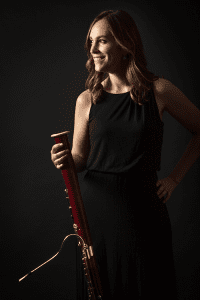
Adapting & moving forward in the time of COVID
Two musician entrepreneurs share how their organizations and ensembles are making changes and staying relevant despite current challenges
Featuring:
Angelica Hairston – Harpist and Founder & Executive Director of Challenge the Stats
Kara LaMoure – Bassoonist, Founding member of The Breaking Winds Bassoon Quartet, and member of WindSync Wind Quintet
Angelica Hairston – Challenge the Stats
About Challenge the Stats:
Challenge the Stats is an organization that empowers artists of color and uses music as a tool for social justice. We highlight these artists through live (and now virtual!) concerts as well as community-based discussions, workshops, and events that showcase BIPOC artistry and advocate for inclusion both on and off the concert stage.
The organization was born out of Angelica’s desire to use music to affect change.
I certainly never expected CTS to expand into a full organization. While studying at the Glenn Gould School of the Royal Conservatory in Toronto, I had my eyes on an orchestral career. During my time there, the news of Trayvon Martin’s death took center stage in the US. It really rocked me to my core and I realized that as an artist, I had a very unique perspective on the world. I was a classical musician who’d studied this specific idiom deeply and I was also incredibly passionate about seeing a more equitable society. I wanted to find a way to mold those two stories together, to find a way to use art as the vehicle to voice the need for justice for communities of color in the United States. What started as a one-off concert during my Masters Degree, now continues on in the work of Challenge the Stats today!
Like all arts organizations, they have had to make major programming changes due to COVID, but they have adapted to online platforms and are using them to further their mission as well as provide service to healthcare workers.
We certainly didn’t expect to be navigating the waters of a global pandemic, but in many ways, we’ve been able to lend our voice to the strong call for change that’s come to the surface in this turbulent time. After having to move our mainstage event due to COVID cancellation, we decided to make the virtual pivot and completely rework our theme. We centered the new concert on bringing light to the disproportionate effect of COVID19 on Black communities and with the recent attention around Black Lives Matter, many individuals and organizations started to take notice. It was incredible to see artists using the platform provided by CTS to perform and to speak out against the realities of racial injustice exposed due to COVID19. We’re also excited about some new initiatives that will allow us to bring virtual concerts to healthcare workers and patients who are directly affected by the virus.
CTS’s recent concert “Music for the Crisis”
Outside of her work, Angelica has been making time to care for her own well-being in new ways.
I’ve been diving deep into the work of the Tricia Hersey and The Nap Ministry lately + making more time for a normal yoga practice with my fav instructor, Chelsea Jackson Roberts. As someone who wears many hats, it’s been powerful to reassess some of my normal daily rhythms and center my wellness during this time of quarantine.
Please visit Angelica on her website and check out Challenge the Stats and their upcoming virtual programs online, on Facebook, and on Instagram.
Kara LaMoure – The Breaking Winds & WindSync
About The Breaking Winds Bassoon Quartet:
The Breaking Winds began as a way to decompress after studio class with my undergrad classmates at the Eastman School of Music. We would goof off in the bassoon studio and read through bassoon quartets. We held our first recital at the dorm during jury week and had to lure people there with bagels, but it ended up being a success. From there we developed our group’s style of mixing comedy, pop culture, and choreography into our original arrangements, which ultimately helped us gain visibility on YouTube. These were the early days of YouTube (late 2000s), so the timing was perfect for a young group like ours to experiment with creative video in the realm of instrumental music. Over the last dozen years or so, the four of us have become ride-or-die best friends, and we keep a unique performance schedule that includes low-key gigs at pubs, master classes and solo appearances with community bands, visits to public schools, and collaborative performances with bassoon ensembles across the world.
For a glimpse of The Breaking Winds in their early days, check out some of their YouTube videos, featuring costumes and choreography!
About WindSync and how Kara got involved:
WindSync rose up around the same time as The Breaking Winds at the Shepherd School of Music. They were a traditional instrumentation wind quintet, but they were trying to accomplish some of the same engagement goals.
In 2016 they had a bassoon search, and it felt like a natural fit for me. At the time I was working a full-time university faculty position, and I wanted to shift my career focus back to performance. WindSync had built up a great reputation with national-level chamber music competition prizes, a management contract, and a nonprofit operating model, and I felt inspired by the ensemble’s desire to bring creativity and freshness to a very traditional, sometimes tired genre. Now as I enter my fifth season with WindSync and the pandemic keeps us apart, creativity will be non-negotiable.
Both ensembles have been adjusting to stay active and relevant during the pandemic:
Lockdown has been challenging for both ensembles because our personnel are spread across the country, and we haven’t been ready to put musicians on planes just yet. Content creation will be more difficult under these conditions. Both groups are hard at work editing video and audio that we recorded before lockdown so that we don’t go quiet.
The Breaking Winds have been getting creative with online challenges and new educational content:
Because The Breaking Winds has always had a bit of a virtual community, the transition to lockdown has felt less shocking for this ensemble. We have periodically initiated bassoon-related challenges on social media, like a parody of the 10 push-up challenge that requires bassoonists to do 10 push-ups while wearing their bassoon backpack (I did a great job on this one, but I had removed my instrument from the case before filming), and playing scales in the round over Zoom. Last week we joined the Metropolitan Youth Symphony for their weekly virtual hangout, where we played bassoon trivia and, of course, aced it! One of our most important audience groups is student bassoonists, and we take commissions from band directors for educational content. As an example in this vein, last month I recorded a series of practice-along videos for a middle school in Texas.
Windsync created a virtual festival and are being flexible with their 2020-2121 programming, including a series of outdoor pop up concerts in support of healthcare workers!
Lockdown felt like a more dramatic change for WindSync, where we suddenly saw 10+ months of live performance activity wiped off the calendar. The first hurdle was creating a virtual version of the Onstage Offstage Chamber Music Festival, which we present in Houston each April over the course of a week. We wanted to keep a similar schedule and preserve as many of the connections between performers, businesses, venues, and audiences as possible. The online version of the festival consisted of 2 virtual concerts from archival video, four live Zoom hangouts, a live music class for kids, and four video premieres, and we linked nine fellow performing groups, five venues, the brewpub and the bookstore in Houston that had agreed to host WindSync events, and our sponsors. Each event engaged about 1,500 viewers across the country, raising awareness of the scene in Houston and of our work outside of concerts, plus hopefully adding a bright spot to the scary early days of lockdown.
Like all performing groups, we will be improvising our 2020-2021 programming to an extent, but we have already put a few pivots in place. Through at least the end of the calendar year 2020, we will perform outdoors only, and following that we are looking into ways to present each concert at both an indoor and an outdoor venue. Our educational work will be virtual. All ticketed events will be pay-what-you-can. Our offstage focus is the support of healthcare workers, and we are planning a series of pop up concerts at Texas Medical Center, directed by the Center for Performing Arts Medicine at Houston Methodist Hospital with guidance from music therapists.
Kara believes that this time has actually made chamber music more available to many audiences, and with that given ensembles the opportunity to affect change and better reach communities.
It’s regrettable that a public health crisis brought this about, but chamber music is having a moment. I am amazed to see orchestras around the world including chamber music in their regular programming now, and to witness the thrilled audience reactions. Optimistically, I see the audience for, or at least awareness of, the chamber music genre growing.
The question I ask myself now is: How long will my ensembles have to essentially function as content creators? If this is actually the new normal, how then do we add the interactivity back into the picture? How do we take care of each other as colleagues, and how do we serve someone on another screen? For me these are the key questions because they address the aspects of live performance that I miss the most.
I think that this period emphasizes the role of musician as creator. WindSync is spending more of our bandwidth on video and audio recording projects, and we are being more aggressive with our commissioning calendar. This is a change for the positive; we have the opportunity now to build the kind of musical environment we want to inhabit in the future.
Monica Ellis (bassoonist of Imani Winds) recently used the word “nimble” to describe chamber ensembles in the New York Times, in the context of Black representation in classical music in a recent article in the New York Times. I love this descriptor—yes, on the one hand our forces are small, but on the other we have the flexibility to effect change more quickly. In my personal practice and with my ensembles, I’m rethinking the definition of community engagement and expanding my circle of collaborators, the first steps to a lifetime of putting in the work.
WindSync’s video of their recent commission from composer Erberk Eryılmaz.
Please find more on Kara and her ensembles by checking out The Breaking Winds online and on Facebook and WindSync online and on Facebook.

Double Bassist Andrea Beyer is an avid performer, teacher and advocate for using music as a tool for social growth. As an orchestral musician, Andrea has performed in concerts at Carnegie Hall and Lincoln Center, as well as national halls in Central and South America and Asia. A fellow at the New World Symphony from 2017-2020, she gained a passion for creative concert design when she conceived of and presented concerts geared towards new audiences, including “Face-off: Battle of the Instruments” and “Music from Beyond the Wall.”
Outside of the orchestral world, Andrea is a passionate teacher and is on the faculty of Bass Works, a summer double bass program in Baltimore, Maryland. She is also the Public Relations Director and a Workshop Coordinator for the MusAid Organization, which supports music programs in under-resourced countries with volunteer music teaching workshops. Andrea holds a Bachelors Degree from Oberlin Conservatory where she studied with Thomas Sperl and a Masters Degree from Yale University where she studied with Don Palma.
Currently based in Austin, Texas, you can connect with Andrea at andreabeyerbass.com or find her on Instagram @wandering_bassline.

